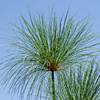Cyperus papyrus (Nile Papyrus, Paper Reed) is a tall perennial herbaceous plant that grows in tropical marshes. It is composed of three stories, adapted to its habitat, the marsh: its roots are in the soil, its stem is in the water and its head is in the air, above the water surface. It has a crawling, perennial rhizome below the soil surface, in the mud. All other parts are annual. They die each year and new ones will sprout in their stead the following year. The stems emerge from the rhizome, and do not branch. The stem is thick, strong, ribbed, with a triangular cross-section and rounded apices. It is green and photosynthesizes. The stem reaches a thickness of up to 5 cm and a height of 4 m. The tissue inside the stem is white, spongy, and contains air spaces that assist the respiration of the plant parts that are immersed in the oxygen-poor environment of the water and the mud. This tissue is enveloped by a sealed green coat. The leaves are rudimentary. They are broad and short, imbricate, brown and not green, concentrated at the base of the stem.
Paper Reed blooms in the summer, from June until October. The single inflorescence is carried at the head of the stem, branched, beautiful and impressive. It spreads out as an umbel with dozens of rays that reach a length of 30 cm. The umbel rays are green and photosynthetic. All the rays emerge from a single point, from an enveloping axil of about half a dozen leaves, which are not as long as the inflorescence rays.
Paper Reed can be found in Israel almost solely in the Hula Nature Reserve, a few plants are also in other places in the Hula Valley and in a single place in the Sharon region. The Hula Valley is currently its northern-most distribution area in the world. In the recent past (beginning of the 20th century), it was more widely distributed in Israel, and was even recorded further to the north, at the Lake of Antioch in Turkey. Today it is a protected plant in Israel. It is also grown as an ornamental plant in gardens bordering on water or in well irrigated gardens.
The global distribution of this species spreads mainly over east Africa, and it apparently covers, densely and almost solely, broad expanses of marsh areas in the Sudan, the size of the entire State of Israel or more. On the other hand, it has become completely extinct in Egypt, which was once regarded as the classic place of the papyrus.
This species is important to man for two reasons that are not purely botanical: as the producer of peat in nature, and as raw material for the first kind of paper made by man. The plant grows most vigorously in the summer, when it enjoys a combination of plentiful water, heat and radiation. Its stems and inflorescences die in the winter. The following summer it grows new stems. Thus, the plant produces a huge amount of new biomass each year, and this material, which sinks when it dies at the end of the year and does not rot because of the anaerobic conditions, turns into peat through a process that lasts many years. Paper Reed is the major plant that contributes to the production of peat in the Hula. Extensive peat areas in the tropical regions around the world and in the Hula Valley were created by this plant.
Young rhizomes are edible after roasting. Their taste is similar to that of almonds and they have a pleasant smell.
Cyperus (Reeds) is a very large genus, which includes 300 plant species (some claim 600 or even 700), which are common on all continents, especially in tropical and subtropical regions. Leaves extend from the base of the plant, whose blade is linear, and the sheath is a closed tube. The plant has a stem (which is not considered to be a culm, because it is not hollow, and this differentiates the Cyperaceae from the Gramineae, which are similar but their stem is hollow), and the head of the stem carries a single inflorescence in the shape of an umbel or capitulum. The stem does not divide, is leafless, and is usually ribbed, with 3 sides. The inflorescence is enveloped by leaf-like bracts. The inflorescence has several spikes, where each is composed of compressed spikelets, and each spikelet contains numerous flowers. The spikelet lemmas are arranged in two imbricate opposite columns. The flower is small, and lacks a perianth. It is not colorful. Each flower has 3 long weak stamens (sometimes 1 or 2) as is usual in flowers that are pollinated by wind. It has a style with 2 or 3 stigmata, usually curled. The fruit is a single-seed nutlet. Most Reed species are found in humid habitats, and are herbaceous water plants with thickened rhizomes or bulbs. The rhizome also serves the plant for vegetative reproduction. In some species the rhizome or bulb is used by man as a source for edible carbohydrates or for medicinal substances. Other species are cultivated in gardens as ornamental plants. The most familiar Reed species are Cyperus papyrus (Nile papyrus, Paper Reed), which was used by the ancients to make paper, and Cyperus rotundus (nut sedge), which is sometimes considered the most harmful weed in the world. Twenty two different species of Reed grow in Israel, many of which are rare and in danger of extinction, because the surroundings of fresh water are in danger of reduction around the entire globe, and especially in Israel, due to drying and draining, depletion of water sources, overuse and pollution.
The Cyperaceae family contains 3,000 species in 85 genera. In Israel there are representatives of 8 genera.
Written by Mike Livne






